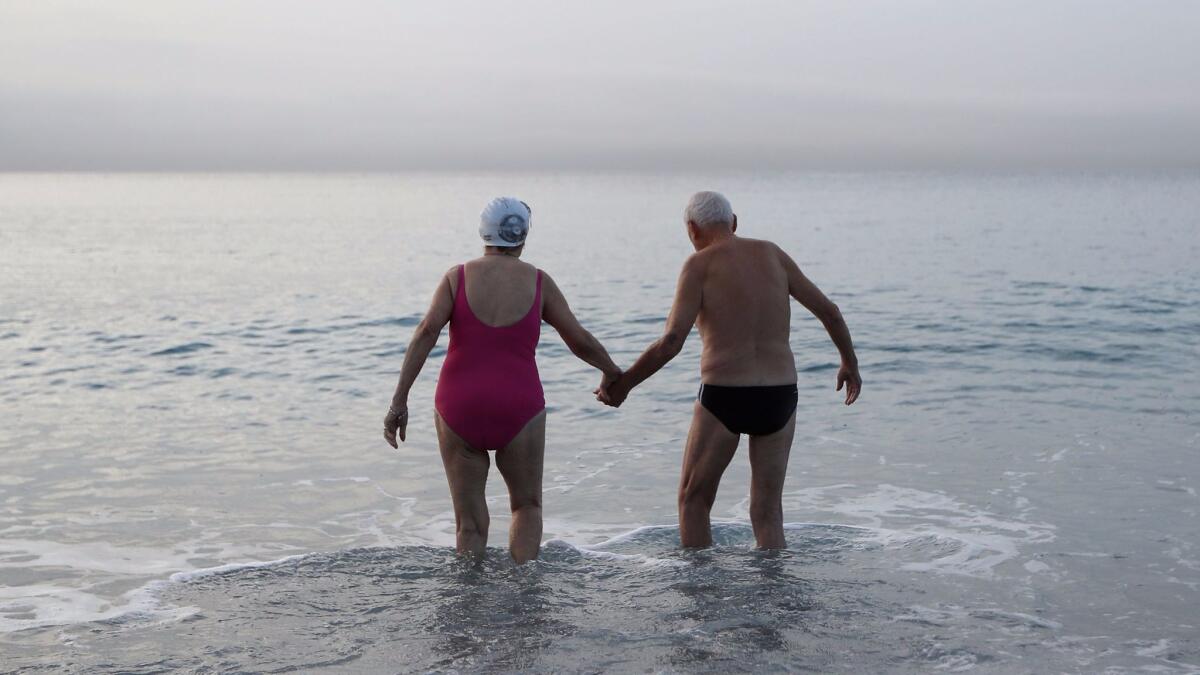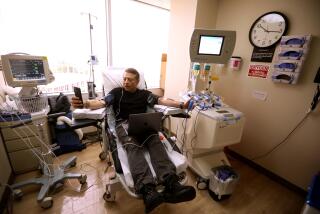There’s more than one way to age. How are you doing it?

- Share via
Most of us think we know what aging looks and feels like. It announces itself with wrinkled skin and gray, thinning hair. It blurs vision, makes joints creaky and, if not rigorously countered, causes things to sag.
But scientists are cataloging far subtler signs of biological aging, evident long before hair is lost and skin starts to crinkle.
For the record:
7:33 p.m. Jan. 18, 2020This article described Judith Campisi as a biochemist at USC. Campisi is based at the Buck Institute for Research on Aging in Novato, Calif., which is not part of USC.
It’s a story told not just in the body’s organs but also in its genes, cells and proteins — even in the bacteria that colonize us. First, one or two molecular processes fall out of whack. Those failures send broader functions off kilter. Sometimes all at once, sometimes gradually, our organs suffer and entire networks — the immune system, for instance — begin to falter.
Understanding how all this happens could allow us to live longer someday. But a nearer goal might produce an even bigger payoff: Defining what aging is and exactly how it progresses may enable us to stay healthy for more of our lives.
Two new pieces of research bring that goal of extending humans’ “healthspan” a bit closer. Both identify biomarkers that help define what it means, at a microscopic level, to age. Both zero in on mechanisms prone to break down as we age — in other words, targets for therapies that could disrupt or delay the aging process.
And both offer some guideposts to measure the effectiveness of elixirs that promise to be (but rarely are) fountains of youth.
In one of the new studies, Stanford University researchers combed through 18 million data points collected from 106 people who were monitored for two to four years. The aim was to detect patterns common to all as we age as well as patterns that vary from person to person.
Emerging from that study, published this week in the journal Nature Medicine, is the idea that individuals age along at least four biological “pathways.” While one person may be most prone to decline in the function of his kidneys, another may experience the most age-related degradation in the liver, the immune system or in metabolic function, the findings suggest.
Most of us likely age along some or all those fronts, if not more, said Stanford geneticist Michael Snyder, who led the research. But classifying people by their personal “aging style,” or areas of greatest vulnerability, may help them identify and forestall their most likely depredations of aging, he said.
In the second study, scientists from USC’s Buck Institute for Research on Aging profiled the known universe of tissues and cells that can reveal the biological age of the human body. It made use of data collected as part of a study that has tracked 3,200 volunteers over the course of their adult lives since 1958.
That atlas of aging’s biomarkers will speed efforts to find and develop drugs that could slow biological aging, said USC biochemist Judith Campisi, who led the work published this week in the journal PLOS Biology. One day, she added, it may allow doctors to give their patients “a clear read-out of how well, or poorly, their various tissues and organs are aging.”
After centuries of snake oil and hucksterism, the struggle against aging has gotten real in recent years. Scientists have honed in on “senescent” cells, which stop dividing under stress, as a key driver of conditions such as cancer, heart disease, diabetes, arthritis and dementia. Since these diseases are more common as we get older, they and their root causes have become central to scientists’ understanding of aging.
Researchers increasingly suspect that when you disrupt the development of one disease of aging, you may help protect against others — a principle called the “unitary theory of fundamental aging processes.” If, for instance, senescent cells and the inflammation they trigger could be brought under control, perhaps many age-related diseases — indeed, unhealthy aging itself — could be averted and the experience of aging might be far less miserable.
That’s the idea behind the search for “senolytics” — drugs or therapies that could remove or disrupt the action of senescent cells. If such anti-aging drugs are to be developed and used safely, researchers will need to recognize the many forms that senescent cells take, and to measure what happens when different members of that group are removed or suppressed.
In the Stanford University study, researchers sequenced genes; analyzed blood, urine and saliva samples; and probed the microbes in the guts and noses of 43 people. The team found 608 molecules that could be assessed and used to identify likely contributors to age-related problems.
The Stanford team came up with four “ageotypes” based on these biomarkers and how they shifted over time. Although the list is likely to expand with further research, the authors suggest that people tend to age most along one of four distinct biological pathways: metabolic, immune, hepatic (or liver) and nephrotic (or kidney).
A person whose dominant ageotype is metabolic might see her A1C, a measure of blood sugar levels, rise with age, potentially leading to Type 2 diabetes. A person with an immune ageotype, on the other hand, might experience increased inflammation across the body, making her more vulnerable to a heart attack and certain cancers.
The work is highly preliminary. Dr. Zoltan Arany who studies aging processes at the University of Pennsylvania’s Perelman School of Medicine, said that while it probed a very wide range of measures and looked for changes over time, determining whether they actually cause aging or are innocent bystanders of the process “will require a lot of further work.”
Even after scientists have established the common roots of age-related diseases — a task that is far from complete — there’s still hard work ahead, said Dr. James L. Kirkland, who studies aging at the Mayo Clinic. If studies like the two published this week are to help humans age better, they’ll have to explain why we age so differently, and predict which of many routes each of us will take.
“At the moment, we’re measuring everything,” Kirkpatrick said. “But the effort will be to narrow down, to get a composite score of biomarkers, that is predictive of a future decline in healthspan.”
Snyder said he shared that long-term goal.
“I can envision a world in which everyone gets their ageotype measured, so that at the earliest sign of acceleration, you can intervene,” he said. For some, that may be taking a cholesterol-lowering statin, and for others, it may mean exercising more.
“This can give you an earlier kick in the butt” to address those vulnerabilities, he said.







